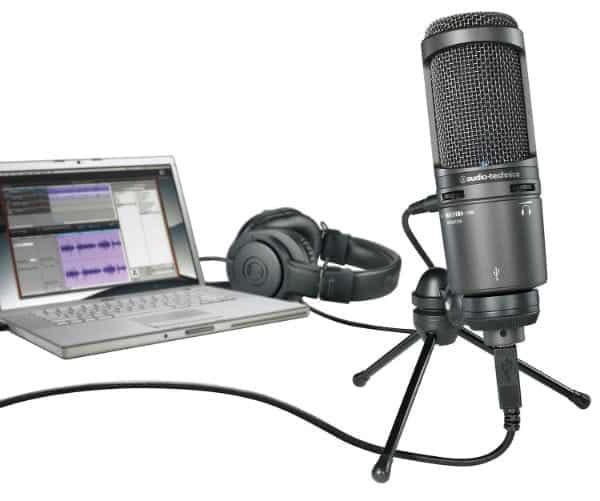There are so many people searching for answers on how to connect a microphone to a laptop or computer for audio recording purposes, and almost every computer today comes with a headphone or microphone input port. This makes connecting a dynamic microphone to a microphone very possible, but the downside of this method is it will be okay for beginners alone and not professionals. This is because this sort of connection will not offer professional sound recordings, and you will want more professional sounds if you are into professional video making, podcasting, and music.
If you make use of a condenser microphone, you will not be able to connect the condenser microphone directly to the computer’s microphone port, because the computer lacks the 48V phantom power required for a condenser microphone to function. However, there are several other options that we want you to take a look at when looking for ways on how to connect a microphone to a laptop or computer.
Content Navigation
How To Connect A Microphone To A Laptop Or Computer

Step 1 – Connecting A USB Microphone To A Computer
When it comes to recording audio, a USB microphone remains the easiest and simplest solution to use with a computer. USB microphones are known to enhance recording’s audio quality, and all it requires to function is for you to plug this microphone directly inside your computer’s USB space or slot. Plugging a USB microphone directly to a computer’s USB port allows users to carry out an audio recording without the use of extra hardware. To get started with this connection, you are required to directly plug in the microphone to the computer and make few adjustments, making you ready make a great sound recording.
Just like the everyday and regular headset, this type of microphones are easy to use especially for people that are familiar with them. The USB microphone is perfect for voiceovers, podcasting, singing, and for use with other instruments. There are other USB microphones designed with a headphone output that allows direct monitoring of the audio when making a recording using headphones. What this means is you can get to listen to your voice and track while you are still making a recording.
However, all products are not designed to be flawless, and this means that even the USB microphone has its own limitations. The limitation of a USB microphone is you can make use of just one USB microphone at a time, meaning a USB microphone might not be a good choice if you intend recording more than one voice at the same time. The USB still remains the best choice if you intend recording just one voice or one track at a time.
Step 2 – Connect An XLR Microphone To A Laptop Or Computer
Using a USB adapter or XLR cable remains the best way to connect an XLR microphone to a computer or laptop. You might consider shopping for an audio interface if you intend connecting a condenser microphone or more than one XLR microphones. An audio interface and XLR cables are required in connecting more than one XLR microphone to a laptop or computer. XLR cables on the other hand come with a triple pin connector, which is used in connecting to an audio interface, and it will interest our readers to know that not all audio interfaces require an external power supply.
This is because the amount of power an audio interface needs is supplied directly from the computer through its USB port. In other cases, an audio interface might require external power supply, and this requires you to plug it into an external power supply source. The next requires you to connect the XLR cable to the microphone, while the other end of the XLR cable is plugged directly into the microphone port on the audio interface. This is the best way to hook up an XLR microphone to a computer or laptop, but you need to take caution when plugging the microphone by ensuring all headphones and speaker are turned down.
This is to avoid producing a loud pop sound that might end up damaging speakers, and the same should be done when connecting dynamic microphones to a computer or laptop.
Connecting A Condenser Microphone To A Computer Or Laptop
For those using a condenser microphone, that will require the assistance of a audio interface that is able to generate about 48 volts of phantom power. This is the amount of power supply a condenser microphone requires to function, and you will also find P48 or 48V phantom power button labeled on most audio interfaces.
Setting Up Microphone Input On Your Laptop Or Computer
The first step you need to take is going through your computer’s audio setting to ensure the USB or audio interface is selected as your output or input device, and you will come across a gain knob on some audio interface, positioned close to the XLR input. However, this gain knob is used for adjusting the microphone’s volume level. The audio interface also comes with a headphone port so you can listen to your tracks or voice while recording, and this feature is also present when using a USB microphone.
It is possible for users to adjust your voice or track’s volume levels on the headphone using the headphone volume knob, and there are two located on an audio interface that allows you to listen to your recordings if you are using a studio monitor. All you have to do is ensure the speaker’s volume is reduced when recording, and this is done to avoid users from hearing their speakers from the microphone while recording.
Final Note
Now, you have learnt new steps in connecting a microphone to a computer or laptop, and these steps are crucial if you want to make an excellent and exceptional audio sound recording. However, you will need an audio interface if you want to obtain a high quality recording, so you might also consider shopping for an audio interface if you do not have one already. We recommend you to check out some guides that talks about the best audio interfaces we have reviewed already on this site.
Related Posts
Best 8 Channel Audio Interface
Best Audio Interface For Mixing And Mastering
Best Audio Interfaces For Voice Over

